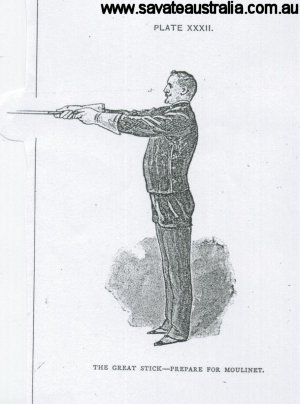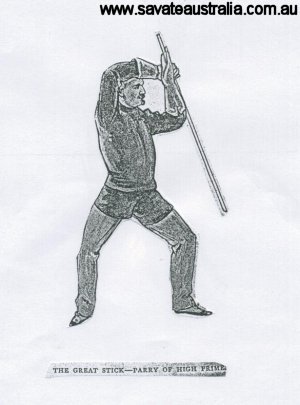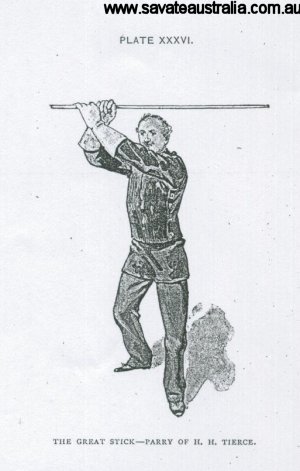A chapter on the great stick based on the French ‘Le Baton” and the Italian “Baston”
from “Cold Steel” – by Alfred Hutton 1889
Its practice is employed in the Italian and French armies, partly to supple the men, for which purpose it is an admirable and highly interesting gymnastic exercise, and partly to lead to proficiency in the wielding the musket and sword-bayonet.
The system of instruction in those countries is somewhat different; the Italian method bears a very close resemblance to the practice of the two-handed sword, as taught by Achille Marozzo in 1536, while the French grafts upon a portion of that ancient play certain movements analogous to those of old English quarter-staff. In my opinion the Italian is the preferable game, and I shall follow it in the main, introducing one or two auxiliary parries from the French.
THE STICK
The stick should be five feet in length, and made of stout rattan cane.
PRELIMINARY LESSONS
First Position
Or Position of “attention.” Face to the front, with the heels together, the left arm dropped easily at the side, and the right hand grasping the stick about eight inches from the butt or thickets end, the arm to be straight and advanced towards the right front, with the nails turned to the right, and the point of the stick resting on the ground close to the outside of the right foot.

GUARD (IN THREE MOTIONS)
Motion 1 – Raise the stick horizontally to the front, the arm quite straight, the hand as high as the shoulder, and the nails down; at the same time make half turn to left, the right tow pointing to the front and the left tow to the left.
Motion 2 - Lower the point, and by bending the right elbow describe a circle on the left of the body, and as close to it as possible, brining the point again to the front with the nails up and the forearm close to the body; at the same time grasp the stick with the left hand immediately blow the right, the point being about on a level with the eyes.
Motion 3 - Bend the knees and bring the right foot forward to the position of guard in fencing.
When these three movements have been acquired correctly, the player must combine them, and come to the guard direct from the first position.
This guard in is fact a quarte, as a parry made directly from it protects the inner line. We now come to the change of position called by the Italians “Fals-guardia.”
FALSE-GUARD
On guard in tierce. From the guard in quarte, turn on the toes of the left foot, and retire the right foot about 18 inches behind the left, the left toe pointing to the front and the right toe to the right, at the same time pass the stick, without quitting the grasp with either hand, from the left side to the right, the left hand passing underneath the right fore-arm; the point of the stick to be on a level with the eyes, the nails of the right hand to be down, and those of the left hand to be up.

Change from tierce to quarte, retiring
Turn on the toes of the right foot, retiring the left about 18 inches behind the right, and come to guard in quarte.

Change to tierce, advancing
Turn on toes of the right foot, bringing the left foot forward and come to guard in tierce.
Change to quarte, advancing
Turn on toes of the left foot, bringing the right foot forward and come to guard in quarte.
THE MOULINETS
As in the sabre practice, so here, the moulinet is the means whereby to obtain suppleness and agility as well to acquire the method of directing the cuts. The Italian school has a large number of these moulinets, of which I think only six are really necessary, namely, two diagonally downwards, two diagonally upwards, and two horizontal – from right to left, and from left to right.
The moulinets should be executed in the first position, that is, standing erect, with the legs straight and the heels together, facing the front. They must be performed slowly at first until they have correctly learned, when the pace must be increased, and the exercise continued eight or ten times.

The rotatory movement of the stick is much assisted by a pulling motion of one hand, and a pushing motion of the other.
The moulinets are:
- Diagonal down from right to left.
- Diagonal down from left to right.
- Diagonal up from right to left.
- Diagonal up from left to right.
- Horizontal from right to left.
- Horizontal from left to right
Motion 1. Extend the arms with the stick pointing to the front a little above the diagonal line on the target, grasping it with the hand touching each other, the left hand behind the right, and the nails downwards.
Motion 2. Bring the stick down with a circular sweep from right to left along the line, causing it to pass close to the left side, and bring it again to the front. The grip of the hands should be relaxed as little as possible.
MOULINET 2
Motion 1. Extend the arms as before, the point of the stick being just above the diagonal line 2.
Motion 2. Raise the point, and by lowering it to the rear, describe a circle close to the right side, the stick traversing the diagonal line upwards from right o left, coming again to the position of the first motion.
MOULINET 3
Motion 1. Advance the arms and stick direct to the front, the shoulders, hands, and point to be in the same horizontal line.
Motion 2. Raise the point, and by lowering it to the rear, describe a circle close to the right side, the stick traversing the diagonal line upwards from righ to left, coming again to the position of the first motion.
MOULINET 4
This must be performed as the last, only, that the stick describes the circle close to the left side, and passes diagonally up from left to the right.
MOULINET 5
Motion 1. As Before
Motion 2. Describe the circle horizontally, the stick traversing the line from right to left, and in the rearward half of the circle just clearing the top of the head.
MOULINET 6
This must be executed as the last, only that the stick describes the circle from left to right.
THE ATTACKS
There are seven cuts, one point and one thrust with the butt.
The cuts and the point may be made either on the lunge or on the pass.
The cuts are in the direction of the moulinets already described.
Cut 1. At left cheek or shoulder.
Cut 2. At right cheek or shoulder.
Cut 3. At left leg.
Cut 4. At right leg.
Cut 5. at left side.
Cut 6. at right side
Cut 7. is a vertical downward cut at the head.
The point is given usually at the breast, the arms at their fullest stretch, without quitting the grip with either hand.
The thrust of the butt is given by throwing the point of the stick vertically backward, and delivering the butt full in the face. This is to be used, a la Lonnergan, on an opponent who rushes in too close.
THE PARRIES
Quarte. From the quarte guard, raise the stick with the point slightly elevated, the right hand being about the height of the left shoulder, and receive Cut 1 at the left cheek.
Low Quarte. Drop the hands as low as the hip, raise the point a little, and receive Cut 5.
H.H (High Horizontal Quarte.) Raise the hands a little higher than the head, and slightly to the front of it, carrying them as much to the left as the extension of the arms will permit, the stick being held horizontally over the head, pointing direct to the right, and receive the vertical cut at the left part of the head or shoulder.

Septime. Drop the point, and receive Cut 3.
High Septime. Drop the point, raise the hands as high as the left shoulder and receive Cut 5.

High Prime. Drop the point perpendicularly to the left front (the right wrist crossing over the left), a little higher than the head. This protects the whole of the left side.

Tierce. From the tierce or false-guard, raise the stick with the point slightly elevated, the right hand being as high as the right shoulder, and receive Cut 2.
Low Tierce. Drop the hands as low as th hip, raise the point a little, and receive Cut 6.
H.H (High Horizontal tierce). Raise the hands a little higher than the head, carrying them as far into right as the extension of the arms will permit, the stick to be held horizontally over the head and pointing direct to the left, and pointing direct to the left, and receive the vertical cut at the right side of the head or shoulder.

Seconde. Drop the point and receive Cut 4.
High Seconde. Drop the point, raise the hands as high as the shoulder, and receive Cut 6.
High Octave. Drop the point perpendicularly to the right front, the hands a little higher than the head. This protects the whole of the right side.

NOTES
My deepest gratitude to Craig Gemeiner for his kind permission in reposting this chapter of Cold Steel to my site! Contents cannot be copied, republished or transmitted without prior consent from him.
Craig Gemeiner specializes in the study of traditional Western fighting arts, particularly Savate and its associated disciplines, and adapting them to modern use. He is one of few instructors in the world teaching ‘Defense dans la Rue’ , a system of self-defense developed in Paris during the late 1800s and has given seminars in Australia, Japan, USA, New Zealand and Italy. For an expanded background on his background, please check out: http://gemeineracademy.wordpress.com/about-us/about-craig-gemeiner/
as well as his various sites below:
http://gemeineracademy.wordpress.com/
http://www.savateaustralia.com/
http://lacannevigny.wordpress.com/
http://defensedanslarue.wordpress.com/
http://bootfighter.wordpress.com/http://www.freewebstore.org/bootfightercatalogue/index.aspx?pageid=1000146













0 comments:
Post a Comment